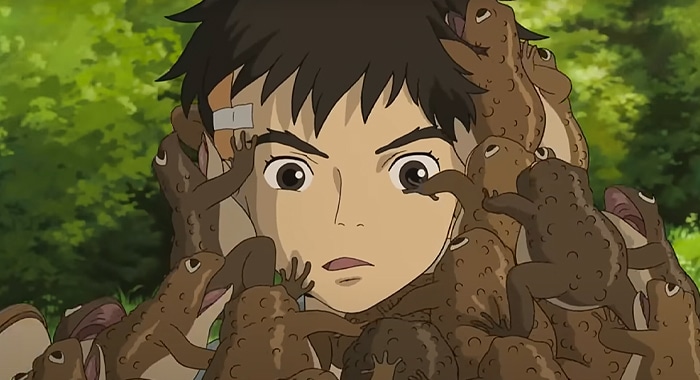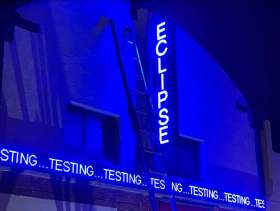Mahito Maki awakens alone in his bedroom to the sound of banging on the window. Expecting peaceful bedrest after a self-inflicted wound, Mahito is expressly annoyed at the disturbance. But the large grey heron responsible for the banging will not be ignored: it’s time for Mahito to get up and face the fantastical journey that awaits.
Hayao Miyazaki, the legendary Japanese animator who announced his retirement in 2013, has felt the call of the heron, too.
This is not the first time he’s ‘retired’ – he tried to do so in 1997 after releasing the environmentalist Edo-period epic Princess Mononoke, then again after children’s fantasy Spirited Away won him an Oscar, and most recently after releasing his “final” film, The Wind Rises.
Read: Princess Mononoke is 25, I’m 20: here’s how it makes me feel
Studio Ghibli, his production company, has now decidedly refrained from calling The Boy and The Heron his ‘final’ film – for Miyazaki is a force that cannot be stopped. His passion for art and lust for life still drive him in such an intense way that everyone knows better than to put the final point on it.
And how lucky are we, that such a master of the animated craft continues to bring us films that delight, that make our minds burst with curiosity and our hearts sing with an optimism that can combat the worst of the world, even if only for two hours?
Read: Scott Pilgrim Takes Off review: Netflix animation gives hero’s journey an extra life
A small note first: the version of the film I saw was dubbed by the English speaking cast, and was shown at a Hoyts media preview that played it on too-small a screen, so a portion of the frame’s top and bottom was always cut off. The English dub was great, the incorrect aspect ratio not so much. I won’t take that into account in my overall review, though.
An autobiography with talking animals
Set during the Pacific War, The Boy and The Heron is an autobiographical tale of sorts, but with more wizards, floating puffball creatures, and a colony of very hungry parakeets. What else could we expect from the man who brought us Totoro, Porco Rosso, and Howl’s Moving Castle? Miyazaki’s childlike whimsy is on full display here, though it is laden with much more serious undertones that come with the territory of talking about war, childhood trauma, and the loss of a parent.
When Mahito’s mother dies in a hospital fire, he and his plane-manufacturing father Shoichi move from Tokyo to the countryside, where Shoichi will marry another woman, and Mahito will be raised by her and a group of gregarious grannies. The country house is also where he will discover a greater purpose, after being beckoned to a mysterious abandoned tower by a talking grey heron.
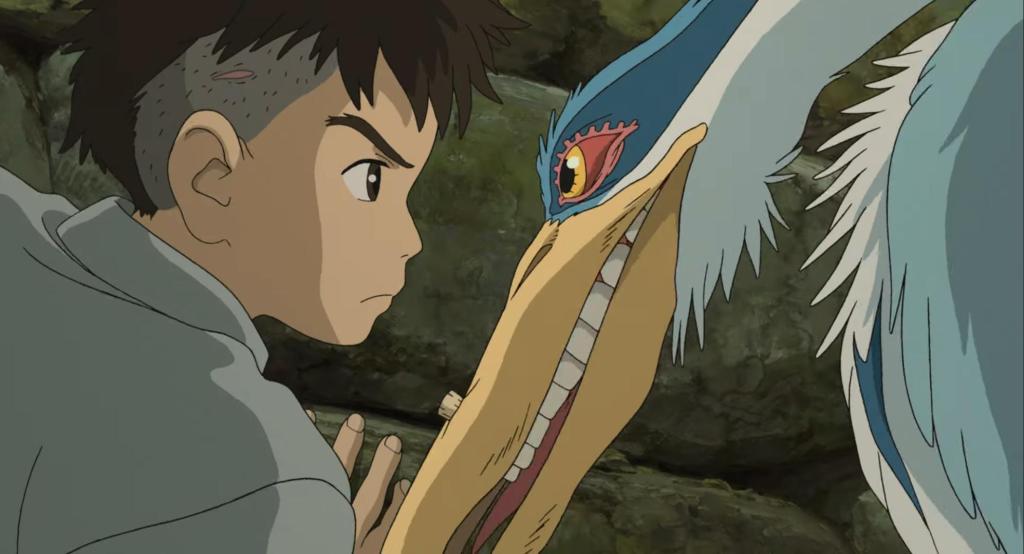
Mahito (Luca Padovan) traverses the tower with one of the grannies, Kiriko – voiced by an almost unrecognisable Florence Pugh – and confronts the heron (Robert Pattinson, equally unrecognisable), who turns out to be a man wearing a heron suit.
He tells Mahito that his mother is still alive, and that he must go on a quest through this tower-world to find her and bring her back. To make things more complicated, his stepmother Natsuko (Gemma Chan) has also been kidnapped.
The staples of a Miyazaki fantasy feature are all here: powerful and headstrong young women (including the fire-controlling Lady Himi), mighty natural presences (a stone that fights back!), and waves of undulating creatures, whether it be frogs or pelicans or the spherical Warawara spirits that leave the tower-world to be ‘reborn as humans’.
His passionate environmentalism, pacifist ethos, and belief in children as smart, capable beings of wondrous potential shine through in a way that confirms he’s back in his element; a real return to form for the master.
The art of Ghibli
That also rings true for the construction of the film: the animation is as fluid and dynamic as ever, evoking real feelings of soaring along the wind, scrambling up a crumbling staircase, and gutting a gigantic fish whose spilling guts threaten to suffocate us.
The character design is marvellous, allowing for real human moments of ugliness and awkward expression. This is something that a lot of major animation studios in the West have lost sight of, opting instead for an airbrushed perfectionism that holds the eye in the same way a perfectly stacked Big Mac would. It gets old quick.
Read: Godzilla Minus One review: roar and emotional
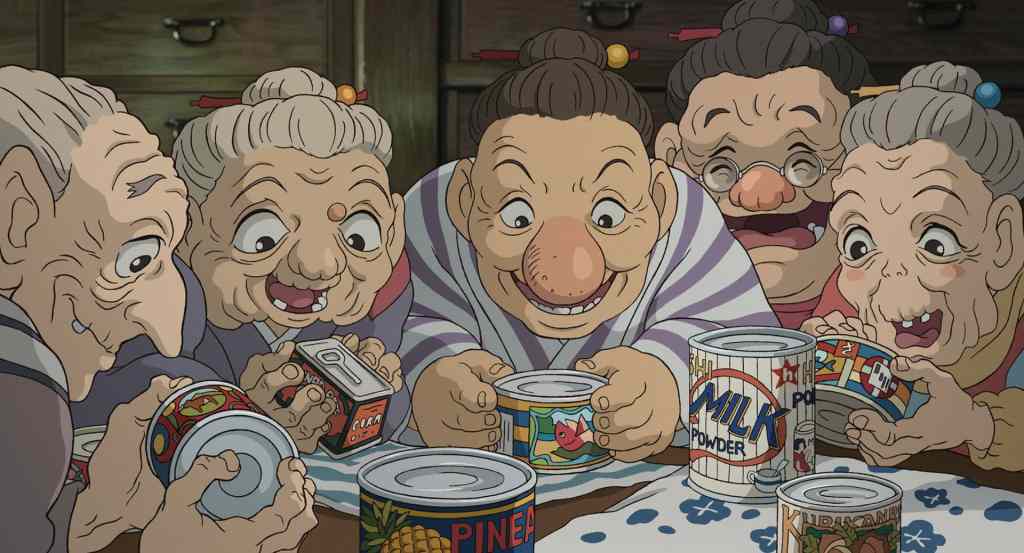
Joe Hisaishi’s piano-based score is purposefully sparse, leaving room for suspense to grow and curiosity to pique. Another master at work, his importance to the work of Miyazaki is on par with the importance of John Williams’ composition on Spielberg’s films. With only a few notes we can hear the call of adventure pulling Mahito away from his dreary life and into the world of fantasy.
The star of the film, it must be said, is the watercolour backgrounds. It’s not hyperbole to liken them to great works of art, delicately imbued with light and shade that induces an involuntary sigh every time a new one appears on screen. Whether watching characters sail across an ocean at dawn, or watching adorable creatures float up to the heavens on a pitch-black night, each background reminds us of what hand-drawn animation is capable of and why we must strive to never let it become a lost art form.
Creation frustration
Though there are a lot of laughs (mostly thanks to the incredible amount of animated bird poo), The Boy and The Heron is also Miyazaki at his most vulnerable, taking elements from his own life like his mother’s struggle with spinal tuberculosis, and his early memories of cities being bombed out by war planes. If you’re expecting “mummy” issues, then yes, the film has plenty – but it’s the strained relationship with his father that is expressed most clearly in both Mahito’s relationship to his dad Shoichi, and the Great Grand Uncle’s relationship to Mahito.
The Great Grand Uncle, voiced superbly by industry veteran Mark Hamill, is a typical wizard character, hanging about in long robes, waiting mysteriously in the background of scenes until it’s time for Mahito to get to the point of his journey. He eventually reveals that he’s looking for a successor to his life’s work, which he expects will be Mahito.
The choice Mahito is faced with reflects two things from Miyazaki’s life: his decision to embrace art instead of his father’s manufacturing job, and his expectation that, having now built the Ghibli empire, his son Goro Miyazaki would follow in his footsteps (something Goro has always been reluctant to do).
This is perhaps Miyazaki’s way of grappling with some of his inner frustrations, but mostly it is about affirming that animation is what he has always been destined to do, whether he likes it or not.
Read: The Hunger Games: The Ballad of Songbirds and Snakes review
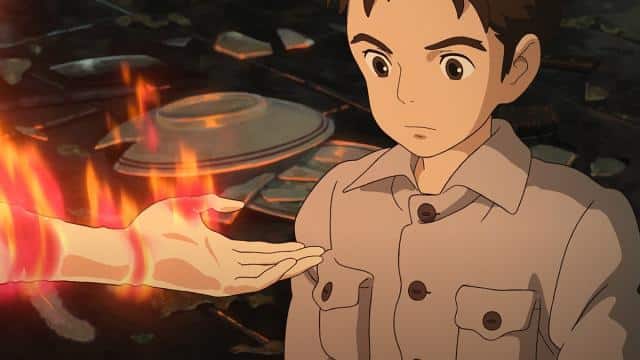
How Do You Live?
Miyazaki knows that animation is his life’s purpose, but that doesn’t come without serious doubts. Mahito can escape to a fantasy world, born from the imagination of his ancestors, but ultimately knows he must return. The insatiable desire for escapism is regarded by Miyazaki as equal parts important and foolish. Does he like that his life’s work is all about art?
A form that, like the tricksy grey heron in the film, can be so elusive? I think that The Boy and The Heron tells us that he both loves it and is endlessly frustrated by it, a sentiment that is relatable to any creative type out there.
I expect that even if the head admin at Ghibli changes the locks one day, insisting that Miyazaki call it quits for his health and enjoy his pension years, he will still be back the very next day, attempting to climb in through the window.
The Japanese title for the film, How Do You Live?, can be read in many ways depending on which word is stressed. How do you live with the purpose of bringing wonder and optimism to a cynical world? How do you go on living when everything about living seems so bleak? How do you (all) live without a sense of wonder and optimism? For Miyazaki, the answer is simply ‘because you must’.
The Boy and The Heron is in cinemas from 7 December 2023
Actors:
Robert Pattinson, Christian Bale, Florence Pugh, Willem Dafoe
Director:
Hayao Miyazaki
Format: Movie
Country: Japan
Release: 07 December 2023
